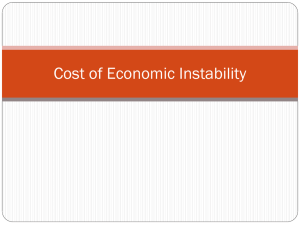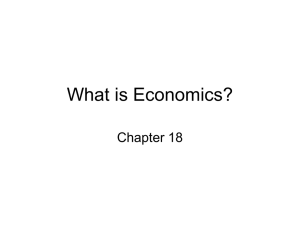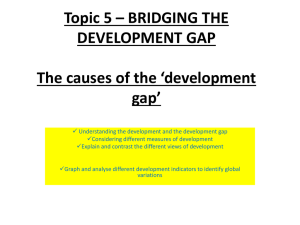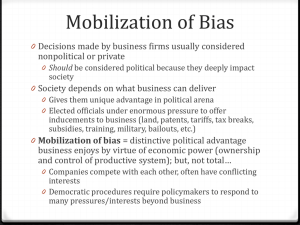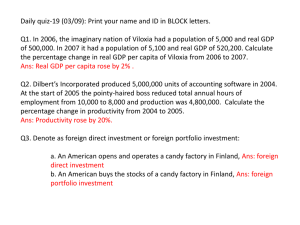Institutions, Human Development and Economic Growth
advertisement
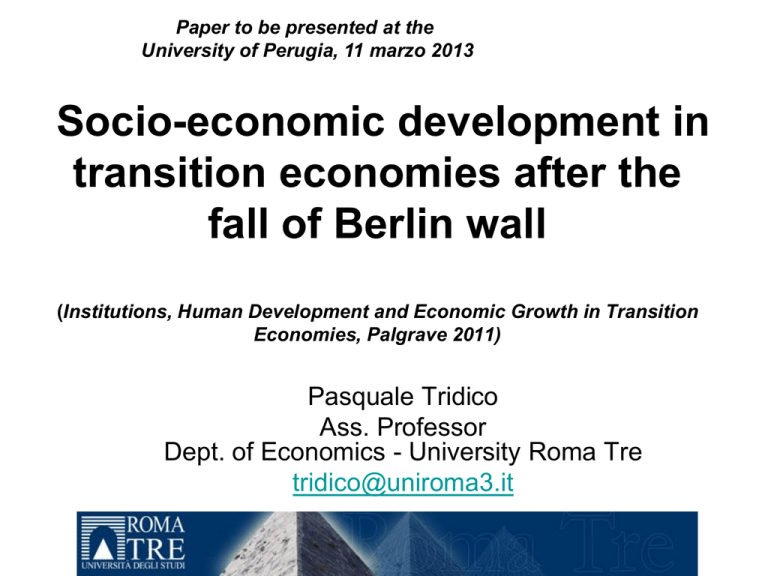
Paper to be presented at the University of Perugia, 11 marzo 2013 Socio-economic development in transition economies after the fall of Berlin wall (Institutions, Human Development and Economic Growth in Transition Economies, Palgrave 2011) Pasquale Tridico Ass. Professor Dept. of Economics - University Roma Tre tridico@uniroma3.it 9 November 1989…the main symbol 20 years after, the financial crisis The end of a dream? Aim of the paper • To analyze the development paths of Transition economies (i.e. East European Countries and Former Soviet Republics) which experienced a transformation from planned economies to market economies since the fall of Berlin wall in 1989. • Developing an interconnected analysis of varieties of capitalism which takes into consideration: – Institutional change – Economic growth – Human development Main hypothesis • Appropriate (political) institutions and socioeconomic variables such as education and health expenditure improve the endowment of people capabilities and lead to better human development. • In turn, an improvement in human development variables such as education level and life expectancy causes an acceleration process in economic growth. Institutions human development growth The reverse of the neoclassical paradigm. How – methodology • Econometric exercises to test the causality hp (OLS for 28 countries) • Following the Varieties of Capitalism literature (Amable, 2003; Jessop 2002; Amoroso 2003; Brenner 2005), countries will be classified by taking into consideration their main macroeconomic characteristics and institutional variables withdrawn from the EBRD such as: – – – – – – Enterprise and Privatisation Market & Competition Trade & Openess Financial System Wage Nexus Social Investments (health and education) How – methodology (2) • Following this classification, I found, among former communist economies, 5 types of socioeconomic models, i.e.: – – – – – competitive capitalist model corporatist model dirigiste model hybrid model state capitalist model. I tried to test whether the type of system has an impact on the path of development of the country, considering both economic growth and human development. Communist states in Eastern Europe and the Soviet Union, 1989 Background and history of transition • 70s and 80s: Lower performance and inefficiencies. ↑ gap East-West • 1980s: Gorbachev’s Perestrojka ; Solidarnosc • June 1989 Semi-free election in Poland and first non-communist gvmnt (Sept. 1989) • October-November 1989 Berlin events • Debate on three routes for transformation: – Social democracy (third way) – Anglo-Saxon model ASAP (Shock therapy) WC – Eur Continental model Corporatist (German)/ Dirigiste (French) Literature and debate… • Shock therapy vs Gradualism (Sachs 1991; Balcerowicz 1993; Nuti, 1999; Kolodko 1997; Aslund 2001) • Institutional change, path dependency and evolutionary theory (Matzner and Kregel, 1992, Murrel, 1992; Rodrik, 1999; Lin 2004) • Sequence of policies and institutions (Stiglitz 1998; Svejnar 2002; Rodrik 2004) • International integration, Eu integration, IMF and WB constraints; FDI (Mundell 1997, Baldwin 1993; Lavigne, 1999; EBRD) New consensus Institutions matter Economic performance and social costs in TEs • As Kornai said (2006, p.37): the transformation has been unique: 1) it took place peacefully and it was an astonishingly fast process towards western mode of development. 2) it was characterised by deep economic troubles. • successes and failures and ≠among countries. Gradualism vs Shock therapy Gradual therapy: Hungary and Slovenia Hungary 8,0 Slovenia 6,0 4,0 2,0 04 20 03 20 02 20 01 20 00 20 99 19 98 19 97 19 96 19 95 19 94 19 93 19 92 19 90 91 19 -4,0 19 19 -2,0 89 0,0 -6,0 -8,0 -10,0 -15%/-20% cumulate -12,0 -14,0 GDP growth in shock therapy countries 1989-2004 15,0 10,0 5,0 0,0 19 89 19 90 19 91 19 92 19 93 19 94 19 95 19 96 19 97 19 98 19 99 20 00 20 01 20 02 20 03 20 04 -5,0 -10,0 -15,0 -20,0 -25,0 -30,0 -35,0 -40,0 -20%/-50% cumulate Poland Slovakia Latvia Czech Republic Lithuania Estonia Delayed unstable with shock (no) therapy Delayed reforms/shock therapy/unstable/uncoordinated/corrupted 10,0 Romania Bulgaria 5,0 04 20 03 20 02 20 01 20 00 20 99 19 98 19 97 19 96 19 95 19 94 19 93 19 92 19 91 19 90 19 19 89 0,0 -5,0 -10,0 -50%/-60% cumulate twice during 1990s -15,0 GDP growth in the Commonwealth of Indipendent States with troubles & conflicts, badly managed, unstable shock (or no) therapy 10 CIS 5 04 20 03 20 02 20 01 20 00 20 99 19 98 19 97 19 96 19 95 19 94 19 93 19 92 19 91 19 90 19 19 -5 89 0 -10 -15 -20 -25 -60%/-65% cumulate during a long period in 1990s Level of real GDP in 2004 and in 2008 (1989=100) CEECs, Baltics, Balkans (B&B) Level Level 2004 2008 CIS Level Level 2004 2008 Slovenia Czech Republic 120 108 136,5 126,7 Russia Belarus 77 100 97,0 134,5 Estonia Poland 102 135 113,7 156,5 Ukraine Kazakhstan 51 94 60,7 124,5 Hungary Lithuania 115 84 119,6 99,8 Armenia Turkmenistan 89 105 131,3 160,3 Slovakia Croatia 114 91 142,4 104,8 Azerbaijan Georgia 71 41 163,0 73,5 Latvia Albania 83 129 98,0 154,5 Uzbekistan Kyrgyzstan 107 75 144,8 94,2 Bosnia & Herzegovin Serbia 57 60 78,9 81,1 Moldova Tajikistan 41 62 57,5 91,9 Montenegro Romania 72 92 101,1 113,2 CIS CEECs-5 (the most advanced) 76 116 111 131 Macedonia 78 95,7 86 107 Bulgaria 84 105,7 Other CEECs and B&B CEECs + B&B 96 119 All TEs 94,7 117 -5,0 La Li tvi th a ua Es nia to Uk nia ra in Ru e M ssia ol d Ar ova m e Hu nia ng Sl ary ov Cz R en ec om ia Sl h R an ov ia ak epu Re blic pu b Cr lic o Bu atia lg ar Se ia r Be bia Bo K sn FY aza laru ia R k s an M hst d ace an He d rz on i e M go a on vin te a ne G gro eo Ky rg rg P ia yz ola R e nd p Ta ubl jik ic ist Al a n Az ban er ia b U Al zb aija lt ra Tur eki n ns km sta itio e n n nis co ta un n tri es 15,0 -15,0 2009. Another 1989? GDP changes in 2009 (in %). Projections for TEs 10,0 5,0 0,0 -10,0 With the crisis, Avg GDP 2009 = Avg GDP 1989. The current economic crisis • The 20° anniversary similar slump as in 1989-90. • The Baltic States, open and small economies, are the most hit (Compet. Cap). • Turkmenistan and Uzbekistan, (State Capitalist economies) have high GDP rates of growth. • Poland (1%), Albania (+1.2%), Azerbaijan (+3%), Tajikistan and Kyrgyzstan (+0,5%) managed relatively better the recession. • Average rate of recession in TEs is -5.2%. In 1990, the first year of transition for almost all TEs, recession was about -4.6% Social & political problems social problems: increase in poverty, inequality, corruption, gender discrimination, unemployment, migration, poverty among farmers and workers, and income divergences between regions within the same country. KOWALIK (2008) CEECS CEECS 5- Balkans CIS 5+ Poverty level 2008 (% pop with 13,8 27,2 25,2 52,4 $4 day) Gini coefficient 2008 30,2 32,2 33,0 35,0 life expectancy in years, 2008 73,6 70,8 72,2 66,9 Voice & Accountability avg 1,04 0,84 0,10 -0,94 00-08 Political Stability avg 00-08 0,78 0,64 -0,49 -0,59 Freedom index 2000-08 3,0 3,0 2,5 1,4 Unemployment rate 08 14,8 11,0 22,0 6,4 Freedom house (Political rights and Civil liberties) 2008 Free (Democracies) Czech Republic Estonia Hungary Lithuania Poland Slovakia Slovenia Latvia Bulgaria Croatia Romania Serbia Partly Free (Defective democracies/Semiauthoritarian regimes) Albania Macedonia Montenegro Bosnia-Herzegovina Georgia Moldova Kyrgykistan Armenia Ukraine 13 countries Not Free (Authoritarian regimes) Azerbaijan Kazakhstan Russia Tajikistan Belarus Turkmenistan Uzbekistan 8 countries 7 countries HDI 2008 0,859 0,776 0,757 Per capita GDP in ppp 2008 15284 5563 6795 Russia Vladimir Putin &Dmitry Medvedev Russia is not an electoral democracy. In the presidential election of March 2008, state dominance of the media was on full display, debate was absent, and incumbent Vladimir Putin was able to pass the office to his handpicked successor, Dmitry Medvedev. A similar issue in 2012 Source: Freedom House 2009 Autocracts: ruling presidents • Tajikistan: President Emomali Rahmon (Rakhmonov), 1994-present • Kazakhstan: President Nazarbayev, 1990-present • Azerbaijan: President Heydar Aliyev, 1993-2003 (died); President Ilham Aliyev, 2003-present • Kyrgyzstan: President Akayev, 1991-2005 (resigned); President Bakiyev 2005-present and civil war in 2009-10 • Uzbekistan: President Karimov, 1991-present • Turkmenistan: President Saparmurat Niyazov, 1992-2006 (died); President Berdymukhammedov, 2006-present • Belarus: Lukashenko • Ukraine: Yanukovich Institutions matter, but which ones? • institutions and development: EBRD, WB and Freedom House indicators are used. • political institutions such as Freedom index (political rights and civil liberties); and Voice&Accountability index associated with socio-economic variables such as education and health expenditure lead to human development, which in turn improves GDP. EBRD Market economy institutions matter? • EBRD indexes rank between 1 and 4+. These indexes concern the following variables: – Enterprise restructuring, – Small and Large Scale Privatisation, – Price liberalisation, – Foreign Trade, – Competition, – Banking and Financial Institutions – Infrastructures. An interesting paradox… GDP level 1989=100 vs EBRD indexes Turkmenistan (160) Belarus (134) Uzbekistan (144) Azerbaijan (163) Slovenia (136) Czech Rep (126) Poland (156) Hungary (124) GDP level 2009 TBUA SCPH Average EBRD indexes ( from 1 to 4,25) 8 Scatter EBRD index 2009 and GDP growth 1989-2009 4 6 Bosnia-Herz Azerbajan Albania Turkmenistan Armenia Uzbekistan 2 Belarus Kazakhstan Russia 0 Poland Slovak Tajikistan Kyrgyz Rep Montenegro Macedonia Slovenia Czech Rep Hungary Latvia Estonia Romania Bulgaria Lithuania Croatia Serbia -2 Georgia Ukraine Moldova 1.5 2 2.5 3 ebrd_ind_avg_09 3.5 4 An interesting paradox: 3 groups of countries 1. the most advanced countries in terms of EBRD index, having also the highest levels of GDP, considering 100 the level of GDP in 1989. 2. countries which never started a process of reforms or are very slow reformers with a relatively high GDP level The third group as in a trap 3. Between Azerbaijan (A) and Slovenia (S) on the horizontal axis, are all the countries with low-to middle level of reforms. These countries are also characterised by low-tomiddle GDP levels. GDP growth, among TEs, is not connected with market economy reforms, which are the ones suggested by EBRD. This is confirmed by a simple regression model GDP (cumulative growth) vs EBRD indexes Model: OLS. Obs: 28; Dependent variable: level of GDP in 2009 (1989=100) Coef. Std. Err. P>t Ebrd index 2009 -5.211364 9.338431 0.582 cons 128.4521 28.42034 0.000 R-squared 0.0118; Adj R-squared -0.0262 Prob > F = 0.31 Varieties of capitalism • EBRD institutions are not correlate with growth. What about the type of socio-economic model? • Amoroso (2003) and Jessop (2002), identified 4 types of economic systems, such as the AngloSaxon model, the Corporatist model, the Dirigiste model, and the Social-Democratic model. Plus Socialist Markets • Amable (2003) found similar stories, with 5 types of capitalisms, taking into consideration 5 institutional forms (competition, wage nexus, financial sector, social protection and education) My contribution for TEs (28 c.) • Competitive capitalism • Corporatist capitalism • Dirigiste capitalism • Hybrid capitalism • State capitalism My contribution for TEs Trade & Financial sector Enterprise and Market & Competition Openess Privat Subsi e Sect dies f Price fdi trad administ co. e Ta Fore State rif bank Banks Stok Wag Edu mkt regul healt __ _ + Compet ++ itive capit __ Corpor ative capit _+ _+ ++ ++ + Dirigist + _ e capit _ + _ _ + _ + _ _ _ + _ _ _ + ++ + ++ _ + Hybrid capit State capit Wage and Social Inv. ++ ++ _ + ++ _ + ++ __ + State Capitalism Hybrid Capitalism Romania Bulgaria Turkmenistan Bosnia Belarus Herzegow. Uzbekistan With dirigiste tendency Ukraine With dirigiste tendency Dirigiste Capitalism Azerbajan Kyrgyz Rep Moldova Russia Tajikistan Montenegro with corpo. tendency Serbia With corporative tendency Corporative Capitalism Hungary Slovenia Competitive Capitalism Estonia Slovak Croatia with compe. tendency Albania with dirigiste tendency Macedonia with compe. tendency Armenia with dirigiste tendency Czech Rep with compe. tendency Georgia with dirigiste tendency Poland with hybrid tendency Kazakhstan with dirigiste tendency Latvia with corpo. tendency Lithuania with corpo. tendency History and path dependency • The majority of CEECs adopted Corpor and Comp models, Austro-Hungarian Empire, German and AngloSaxon influence. • The Hybrid model: countries with a very mixed historical and political background such as Bosnia-Her., Romania and Bulgaria unstable transition. (Limited Poland) . • CIS: almost all of them adopted Dirigiste capitalism and State capitalism models. far away from the French one. Here is linked to semi-authoritarian regimes “State leaders” or parties or families or oligarchs. • The tradition and the development of liberal values play also a role. In CIS democracy and freedom are restricted Poverty, 2008 (%pop 4$ day) Gini coefficient, 2009 Voice& Account. 00-09 Fredom Index (avg 2001-09) Unemployme 09 GDP growth average 1989-2009 Level GDP 2008 (1989=100) GDP per capita, 2009 HDI 2009 HDI 1990 Life expectancy in years, 1995 Life expectancy in years, 2009 Life expe growth 95-09 EBRD average indexes (2008) Competi Corporta Dirig Hybrid State capitalis capitalis capit capitalis Capitalism 45,0 6,1 54,4 37,7 30,7 32,1 27,5 37,2 34,2 35,7 0,050 0,893 -0,763 0,437 -1,157 2,20 2,80 1,29 2,76 1,00 10,2 2,36 14,5 12,2 1,05 0,37 13,0 1,20 4,0 2,75 133,3 116,7 98,0 98,3 146,5 10254 17641 4909 8766 3403 0,814 0,759 70,7 0,869 0,807 73,0 0,761 0,756 0,760 68,0 0,822 0,799 71,0 70,5 73,0 65,6 71,9 65,7 -0,24 0,0 -3,60 1,36 -2,02 3,253 3,437 2,646 3,281 1,763 0,785 67,0 An overall and comparative socio-economic development rank Models Total score Standardized (+/-14) value Corportatist capitalism +9 1.26 Hybrid capitalism +1 0.14 Competitive capitalism 0 0 State Capitalism -4 -0.56 Dirigiste capitalism -6 -0.84 Corporative capitalism: medium to high level of privatisation, wage regulation, high level of Social investment. Freedom and democratic institutions Some mix: Fdi control, trade Tariff revenue, Foreign owned bank, State owned bank, stock market capitalisation Type of models and growth • Variables which identify a competitive capitalist model such as competition, high levels of trade (or similarly, high share of foreign-owned banks), a developed private sector, and advanced reforms towards a market economy (high EBRD index), are not significant for economic growth nor for the per capita GDP GDP and growth vs competitive capitalist model Model: OLS. Obs: 28; Dependent variable: level of GDP per capita 2008 var Coef. Std. Err. P>t competition 3766.329 4252.645 0.385 priv_sec ebrd_index Model: OLS. Obs: 28; Dependent variable: GDP growth 1989-2009 Coef. Std. Err. P>t .9780798 1.623979 0.553 -194.0288 154.7295 0.222 -.0028262 .0590873 0.962 9347.72 -1.684986 2.490531 0.505 foreign_bank -40.30874 42.20938 0.350 .0084233 .0161187 0.606 _cons 3.686458 2.253249 0.115 6521.848 0.165 -12507.37 5900.486 0.045 R-squared 0.5487; Adj R-squared 0.4702 R-squared 0.0511; Adj R-squared 0.1139 Prob > F = 0.0008 Prob > F = 0.8686 GDP and HDI vs Corporatist capitalist model • On the contrary GDP and HDI in particular are correlated with 1) higher levels of public expenditure in health and education and 2) democratic political rights and civil liberties. • These two variables identify better a corporative capitalist type of socioeconomic model. Scatter for Factor 1 and 2 Estonia 1 Latvia Slovak Czech Rep Lithuania Poland Hungary Bulgaria Romania Croatia Slovenia Bosnia H Kyrgyz Rep Macedonia Albania Montenegro 0 Georgia Armenia Ukraine Serbia Kazakhstan Moldova Scores for factor 1 Tajikistan -1 Russia Azerbajan Uzbekistan -2 Belarus Turkmenistan -2 Source: own elaboration -1 0 Scores for factor 2 1 2 Factor analysis • Hungary and Slovenia have higher levels of Factor 2, which characterizes better a Corporative model, • Slovak and Estonia have higher levels of Factor 1 which characterizes a Competitive capitalist model. • CIS are scattered close to each others, identifying the Dirigiste model, and Turkmenistan, Belarus and Uzbekistan, staying in another corner of the figure, are captured in the State capitalist model. • A Hybrid model brings together Romania and Bulgaria. GDP and HDI vs relevant variables for the Corporatist capitalist model Model: OLS. Obs: 28; Dependent variable: HDI 2007 Std. Err. P>t Model: OLS. Obs: 28; Dependent variable: GDP per cap 2008 Var Coef. Coef. Std. Err. P>t Pol Rig & Civ Lib -.02383 .00389 0.000 -2081.45 Exp edu&healt .006712 .00313 0.044 1124.628 432.4085 0.017 cons .836691 .03493 0.000 7341.524 4825.683 0.143 538.0074 0.001 R-squared 0.7629; Adj R-squared 0.7403 R-squared 0.6478; Adj Rsquared 0.6143; Prob > F = 0.0000 Prob > F = 0.0000 From institutions to development through capability • Main assumption: countries which experienced ↑ in HD economic growth: consequence of an expansion of people capabilities. • appropriate institutions + investments socio-economic dim. better level of capability endowment: Institutions Capabilities & HD Growth (with Development) What is an institution • institutions are rules and social norms which structure social interaction. They can effectively enlarge/diminish capabilities, by the way in which they affect political rights (freedom, democracy, participation) and social rights (public resources for collective purposes). The link between institutions & capabilities A country with democracy & freedom people capabilities (because of collective lobbying) +than a country where these rights are restricted. Public choices collective benefits the Capability curve C HDI & Capabilities DEs B AEs ETEs A Institutions: freedom, participation, democracy, social rights Testing hp: from institutions to human development HD 1HealthExp 2 Freedom 3 Participation & Edu OLS model - Obs 28 Dependent Variable: HD (average LEI and EI) 2007 I Regression with education and II Regression with interaction VA V&A and Edu Variables Coeff. Variables Coeff. .0052873** .0066548** Health expenditure (.0031919) Health expenditure (.0027672) . 0122228* 0096823* Freedom Freedom (.0030409) (.0025019) -.0017852 0000709** Education VA_Edu (.0063819) (.0000377) expenditure (Edu) .0010574 (.001026 Voice & 5) Accountablity (VA) Constant . .780512* 7685463* (.0182849) Constant (.0093681) R-squared 0. 7792= Adj R-squared 0. 7940 Adj R-square 0. 7240 R-square 0. 8221 Mean dependent var 0.8467 Mean dependent var 0.8467 Prob(F-statistic) 0.000000 Prob(F-statistic) 0.000000 Significance level at * = 1%, ** = 5%; *** = 10%. From human development to economic growth Dependent Variable: GDP per Capita PPP) Method: Least Squares Included observations: 26 Variable Coefficient Std. Error Life Expectancy 1.661743 0.414746 index Education index 2.127335 0.538301 Constant -2.563643 0.627456 Adjusted R-squared 0.545264 Log likelihood 26.54466 Durbin-Watson stat 1.193667 Prob(F-statistic) 0.000116 (US$, P-Value 0.0006* 0.0006* 0.0005* Dependent Variable: GDP per Capita 2008 (US$, PPP) Method: Least Squares Included observations: 28 Variable Coefficient Std. Error P-Value Life Expectancy 53177.6 0.414746 0.000* index Education index 127157.2 0.538301 0.000* Constant -148035.4 0.627456 0.000* R-squared 0.7491 Adjusted R-squared 0.7290 Prob(F-statistic) = 0.0000 Test for 2002 GDPppp C 1 LEI 2 EI i Test for 2008 Pairwise Granger Causality Tests Included observations 26 Null Hypothesis: F-Statistic Probability Hp EDUCATION does not Granger Cause GDP 0.07391 0.92902 Rejected GDP does not Granger Cause EDUCATION 5.17497 0.01607* Accepted LIFE does not Granger Cause GDP 0.25266 0.77930 Rejected GDP does not Granger Cause LIFE 3.70301 0.04385* Accepted There can be EG without HD but if there is HD, then there will definitely be economic growth. HD: sufficient condition Path of development and democracy (2) (1) HDI/Eco. Growth with distribution Democracy (3) (0) Social Capital & Middle class (0) middle class and social capital create democratic institutions (1); then democracy, social capital and middle cl. bring about human development and economic growth (2). the middle class, and social capital are reinforced by the human development and growth (3) (top down process). Final remarks 2 1. Dirigiste capitalist economies perform worst: growth without development; voice without social opportunities 2. State capitalist economies had growth without voice do not enjoy pluralism and democracy 3. Poverty and inequality in the majority of countries. CEECs better than CIS and former Yugoslav. A common thing in the life expectancy 4. The worst situation can be found in Russia, Ukraine, Moldova, Tajikistan, Kyrgyzstan and Georgia, where both the levels of HDI and of GDP are still lower today than in 1989-90. 4. Higher HDI is always associated with democracy and semidemocracy regimes rather than authoritarian regimes. Competitive vs Corporatist model of Capitalism • EBRD market oriented reforms are not significant for growth. • Competitive capitalist model var. (competition, +trade/foreign-owned banks, +private sector, +reforms toward a market economy) are not significant for economic growth nor for the per capita GDP • Corporatist capitalist model var (+levels of public expenditure in health and education and democratic political rights and civil liberties) cause a higher HDI and GDP per capita. Final Remarks on Variety of capitalism • Freedom and social rights: the corporative model is able to guarantee a better combination! As a good soc.team wt 11 • Countries of the corporative model show always better socio-economic var.: inequality, poverty, Voice & Accountability, HDI. Countries of the Dirigiste model show worse indicators. • A better institutional framework improves the level of HD: institutional framework human development economic growth

